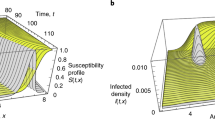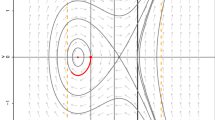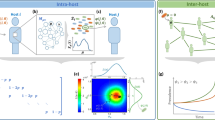Abstract
We consider the evolution of mutation rate in a seasonally forced, deterministic, compartmental epidemiological model with a transmission–virulence trade-off. We model virulence as a quantitative genetic trait in a haploid population and mutation as continuous diffusion in the trait space. There is a mutation rate threshold above which the pathogen cannot invade a wholly susceptible population. The evolutionarily stable (ESS) mutation rate is the one which drives the lowest average density, over the course of one forcing period, of susceptible individuals at steady state. In contrast with earlier eco-evolutionary models in which higher mutation rates allow for better evolutionary tracking of a dynamic environment, numerical calculations suggest that in our model the minimum average susceptible population, and hence the ESS, is achieved by a pathogen strain with zero mutation. We discuss how this result arises within our model and how the model might be modified to obtain a nonzero optimum.





Similar content being viewed by others
Notes
(13) is a second-order, linear ODE so there are two linearly independent solutions; however, only one of them (the Gaussian probability density) is normalizable so that the integral of the solution is equal to unity.
References
Abrams PA (2001) Modelling the adaptive dynamics of traits involved in inter- and intraspecic interactions: an assessment of three methods. Ecol Lett 4:166–175
Alizon S, van Baalen M (2005) Emergence of a convex trade-off between transmission and virulence. Am Nat 165(6):E155–E167
Anderson RM, May RM (1991) Infectious diseases of humans: dynamics and control. Oxford University Press, Oxford
Andre JB, Hochberg ME (2005) Virulence evolution in emerging infectious diseases. Evolution 59(7):1406–1412
Bergstrom CT, McElhany P, Real LA (1999) Transmission bottlenecks as determinants of virulence in rapidly evolving pathogens. Proc Natl Acad Sci USA 96(9):5095–5100
Berngruber TW, Froissart R, Choisy M, Gandon S (2013) Evolution of virulence in emerging epidemics. PLoS Pathog 9(3):e1003,209
Bolker BM, Grenfell BT (1993) Chaos and biological complexity in measles dynamics. Proc R Soc B 251:75–81
Bolker BM, Nanda A, Shah D (2010) Transient virulence of emerging pathogens. J R Soc Interface 7(46):811–822
Cushing JM (1980) Two species competition in a periodic environment. J Math Biol 10(4):385–400. doi:10.1007/BF00276097
Day T, Gandon S (2007) Applying population-genetic models in theoretical evolutionary epidemiology. Ecol Lett 10(10):876–888. doi:10.1111/j.1461-0248.2007.01091.x
Day T, Proulx S (2004) A general theory for the evolutionary dynamics of virulence. Am Nat 163(4):E40–E63. doi:10.1086/382548
Drake JW (1991) A constant rate of spontaneous mutation in DNA-based microbes. PNAS 88(16):7160–7164
Drake JW, Charlesworth B, Charlesworth D, Crow JF (1998) Rates of spontaneous mutation. Genetics 148(4):1667–1686
Fisher RA (1930) The genetical theory of natural selection. Clarendon, Oxford
Froissart R, Doumayrou J, Vuillaume F, Alizon S, Michalakis Y (2010) The virulence-transmission trade-off in vector-borne plant viruses: a review of (non-)existing studies. Philos Trans R Soc B Biol Sci 365(1548):1907–1918. doi:10.1098/rstb.2010.0068
Herbeck JT, Mittler JE, Gottlieb GS, Mullins JI (2014) An HIV epidemic model based on viral load dynamics: value in assessing empirical trends in HIV virulence and community viral load. PLoS Comput Biol 10(6):e1003,673
Holmes EC (2013) What can we predict about viral evolution and emergence? Curr Opin Virol 3(2):180–184
Johnson T (1999) Beneficial mutations, hitchhiking and the evolution of mutation rates in sexual populations. Genetics 151(4):1621–1631
Kimura M (1960) Optimum mutation rate and degree of dominance as determined by the principle of minimum genetic load. J Genet 57(1):21–34
Kimura M (1967) On the evolutionary adjustment of spontaneous mutation rates. Genet Res 9(01):23–34
Leigh EG Jr (1970) Natural selection and mutability. Am Nat 104(937):301–305
Leigh EG Jr (1973) The evolution of mutation rates. Genetics 73(Suppl 73):1–18
Lloyd AL (2004) Estimating variability in models for recurrent epidemics: assessing the use of moment closure techniques. Theor Popul Biol 65(1):49–65
Mollison D (1991) Dependence of epidemic and population velocities on basic parameters. Math Biosci 107:255–287
Moran NA, Wernegreen JJ (2000) Lifestyle evolution in symbiotic bacteria: insights from genomics. Trends Ecol Evol 15(8):321–326. doi:10.1016/S0169-5347(00)01902-9
Orr HA (2000) The rate of adaptation in asexuals. Genetics 155(2):961–968
Park SC, Krug J (2013) Rate of adaptation in sexuals and asexuals: a solvable model of the Fisher–Muller effect. Genetics 195(3):941–955
R Core Team (2014) R: a language and environment for statistical computing. R Foundation for Statistical Computing, Vienna. http://www.R-project.org/
Regoes RR, Hamblin S, Tanaka MM (2013) Viral mutation rates: modelling the roles of within-host viral dynamics and the trade-off between replication fidelity and speed. Proc R Soc Lond B Biol Sci 280(1750):2012–2047
Shirreff G, Pellis L, Laeyendecker O, Fraser C (2011) Transmission selects for HIV-1 strains of intermediate virulence: a modelling approach. PLoS Comput Biol 7(10):e1002185. doi:10.1371/journal.pcbi.1002185
Sniegowski PD, Gerrish PJ, Johnson T, Shaver A (2000) The evolution of mutation rates: separating causes from consequences. BioEssays 22(12):1057–1066
Soetaert K, Petzoldt T, Setzer RW (2010) Solving differential equations in R Package deSolve. J Stat Softw 33(9):1–25. http://www.jstatsoft.org/v33/i09
Tilman D (1982) Resource competition and community structure. Princeton University Press, Princeton, NJ
Turelli M, Barton NH (1994) Genetic and statistical analyses of strong selection on polygenic traits: what, me normal? Genetics 138(3):913–941
Acknowledgments
The authors thank Colleen Webb for valuable feedback. The authors also thank the Natural Sciences and Engineering Research Council of Canada (NSERC) for their financial support through the Undergraduate Student Research Awards and Discovery grants programs.
Author information
Authors and Affiliations
Corresponding author
Electronic supplementary material
Below is the link to the electronic supplementary material.
Appendices
Appendix 1: General Mutation Spectrum
Generally, one could write (1b) as
where m is the mutation rate (although a different mutation rate than D defined below) and \(K(\alpha ^\prime , \alpha )\) is the mutation spectrum (the rate of mutation from strain \(\alpha ^\prime \) to \(\alpha \)). \(K(\alpha ^\prime , \alpha )\) must have the following properties:
-
(i)
\(K(\alpha ^\prime ,\alpha ) \ge 0\) for all \(\alpha ^\prime ,\alpha \in [0,\infty )\)
-
(ii)
\(\int _0^\infty K(\alpha ^\prime ,\alpha )~d\alpha = 1\).
Property (i) follows from probabilities of mutation being non-negative and property (ii) ensures that mutation cannot change the total number of infectious individuals. This mutation spectrum can accommodate very general models of mutation (even among discrete phenotypes through the use of Dirac delta functions). Our diffusion model of mutation follows from this general spectrum under the assumptions that \(K(\alpha ^\prime , \alpha )\) is symmetric in the sense that
and for each \(\alpha \), \(K(\alpha ^\prime , \alpha )\) is narrowly peaked such that
Using (33) and (34), as well as applying property (ii), in (32) we obtain
where \(D(\alpha ) \equiv (m/2)\int _0^\infty (\alpha ^\prime - \alpha )^2 K(\alpha ^\prime , \alpha )~\hbox {d}\alpha ^\prime \). Finally, we obtain (1b) by assuming that \(D(\alpha )\) is constant for all \(\alpha \).
Appendix 2: Derivation of Second-Order Moment Equations
Here we wish to approximate the full model, given by (1), by characterizing the infectious distribution, \(i(\alpha , t)\), according to its first two moments. In addition, we shall assume that \(i(\alpha , t)\) is normally distributed in \(\alpha \) for every \(t \ge 0\) and that \(i(0, t) \approx 0\) (i.e. dynamics occur far from the boundary).
The mean virulence, \(\left\langle \alpha \right\rangle \), is given by
and hence its time derivative is
We now substitute \(\partial i/\partial t\) for the expression in (1b) and simplify in order to obtain
where \({\sigma ^2_\alpha }= \left\langle \alpha ^2 \right\rangle - \left\langle \alpha \right\rangle ^2\) is the variance of the virulence in the infectious population. We can now also take a Taylor expansion of \(\beta (\alpha , t)\) about \(\left\langle \alpha \right\rangle \) to second order in \(\alpha \),
where the \((\alpha - \left\langle \alpha \right\rangle )^3\) term averages to zero since we have assumed normality (normal distributions have no skew). Therefore, the equation for the time evolution of \(\left\langle \alpha \right\rangle \) is
as stated in (5c).
The time evolution for the variance is derived in a similar fashion. First note that, similar to the time derivative of \(\left\langle \alpha \right\rangle \),
which, upon substitution of (1b), simplifies to
This result allows us to easily compute the time derivative of \({\sigma ^2_\alpha }\),
The term in brackets is the third cumulant of the infectious distribution and therefore is zero under our assumption of normality. We again expand \(\beta (\alpha , t)\) to second order in \(\alpha \). From this we obtain
Finally, we use the fact that the fourth central moment is equal to the sum of the fourth cumulant (which again is zero by the assumption of normality) and three times the variance squared. This gives the result quoted in (5d),
Equations (5a) and (5b) are obtained directly from the full model defined in (1) by simply expanding \(\beta (\alpha , t)\) to second order as in the above two cases.
Rights and permissions
About this article
Cite this article
Birch, M., Bolker, B.M. Evolutionary Stability of Minimal Mutation Rates in an Evo-epidemiological Model. Bull Math Biol 77, 1985–2003 (2015). https://doi.org/10.1007/s11538-015-0112-6
Received:
Accepted:
Published:
Issue Date:
DOI: https://doi.org/10.1007/s11538-015-0112-6




